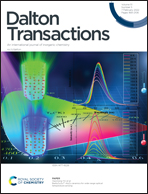A nonsymmetric Dy2 single-molecule magnet with two relaxation processes triggered by an external magnetic field: a theoretical and integrated EPR study of the role of magnetic-site dilution†
Abstract
The 1 : 2 reaction between Dy(O2CMe)3·4H2O and 1-acetyl-2-napthol (LH) in MeOH has provided access to the complex [Dy2L6(MeOH)]·MeOH (1·MeOH) in a good yield. The structures of the isomorphous complex 1·MeOH and its doped diamagnetic yttrium analogue [Dy0.14Y1.86L6(MeOH)]·MeOH (Dy@Y2) have been determined by single-crystal X-ray crystallography and characterized based on elemental analyses, IR spectra, and powder X-ray patterns. Combined dc and ac magnetic susceptibility and the magnetization data for 1 suggest that this complex shows slow magnetic relaxation. Under a 0 Oe dc field, a single relaxation mechanism is seen while two magnetization relaxation processes are evident under a 1500 G external magnetic field. The fit to the Arrhenius law has been performed using the 1.8–10 K ac data, affording an effective barrier for the magnetization reversal of 13 K and 7 K under the external dc field. Theoretical studies have been performed using ab initio and density functional methodologies to understand the electronic structure and the magnetic relaxation dynamics resulting from the single DyIII ion as well as from the dinuclear exchange-coupled states. Rich powder EPR spectra at the X-band and Q-band were obtained from Dy@Y2, as well as from the 1·MeOH dimer, while simulation studies revealed the ferromagnetic nature of the interaction between the DyIII ions in accordance with theoretical studies.



 Please wait while we load your content...
Please wait while we load your content...